Applied Mathematics
Vol. 4 No. 9 (2013) , Article ID: 36450 , 5 pages DOI:10.4236/am.2013.49167
The Solution of Binary Nonlinear Operator Equations with Applications
Department of Mathematics, Shangqiu Normal College, Shangqiu, China
Email: bmqiao@126.com
Copyright © 2013 Baomin Qiao. This is an open access article distributed under the Creative Commons Attribution License, which permits unrestricted use, distribution, and reproduction in any medium, provided the original work is properly cited.
Received June 6, 2013; revised July 6, 2013; accepted July 13, 2013
Keywords: Cone and Partial Order; Solution; Nonlinear Binary Operator; Operator Equations
ABSTRACT
In this paper, the existence and uniqueness of solution systems for some binary nonlinear operator equations are discussed by using cone and partial order theory and monotone iteration theory, and the iterative sequences which converge to solution of operator equations and error estimates for iterative sequences are also given. Some corresponding results are improved and generalized. Finally, the applications of our results are given.
1. Introduction
In recent years, more and more scholars have studied binary operator equations and have obtained many conclusions, such as references [1-3] etc. In this paper, we will discuss solutions for ordinal symmetric contraction operator and obtain some general conclusions; some corresponding results of references [4,5] are improved and generalized. Finally, we apply our conclusions to two point boundary value problems with two degree superlinear ordinary differential equations.
In the following, let E always be a real Banach space which is partially ordered by a cone P, P be normal cone of E, N is normal constant of P, partial order ≤ is determined by P,  denotes zero element of E. For
denotes zero element of E. For  and
and , let
, let

denotes an ordering interval of E.
The concepts of normal cone and partially order, mixed monotone operator, coupled solutions of operator equations etc. see [6].
Definition 1.1. Let  be binary operator, A is said to be L-ordering symmetric contraction operator if there exists a bounded linear operator
be binary operator, A is said to be L-ordering symmetric contraction operator if there exists a bounded linear operator , which its spectral radius
, which its spectral radius  such that
such that

for any , where L is called contraction operator of A.
, where L is called contraction operator of A.
2. Main Results
Theorem 2.1. Let  be L-ordering symmetric contraction operator, and there exists a
be L-ordering symmetric contraction operator, and there exists a , for any
, for any ,
,  such that
such that
 . (1)
. (1)
If condition
(H1)  ;
;
or
(H2) 
holds, then the following statements hold:
(C1)  has a unique solution
has a unique solution , and for any coupled solution
, and for any coupled solution  such that
such that ;
;
(C2) For any , we make up symmetric iterative sequences
, we make up symmetric iterative sequences
 (2)
(2)
then
 and for any
and for any , there exists a natural numbers m, if
, there exists a natural numbers m, if , we get error estimates for iterative sequences (2):
, we get error estimates for iterative sequences (2):
 .
.
Proof. Set
 if condition (H1) or (H2) holds, then it is obvious
if condition (H1) or (H2) holds, then it is obvious
 by (1), we easily prove that
by (1), we easily prove that  is mixed monotone operator, and for any
is mixed monotone operator, and for any  such that
such that
 where
where

is a bounded linear operator, I is identical operator.
By the mathematical induction, we easily prove that

where
 .
.
By the character of normal cone P, we implies

For any , since
, since

so there exists a natural numbers m, if , such that
, such that

and constant .
.
Considering mixed monotone operator  and constant
and constant , by Theorem 3 in reference [3], then we know
, by Theorem 3 in reference [3], then we know  has an unique solution
has an unique solution , and for any coupled solution
, and for any coupled solution  such that
such that
 .
.
From

and uniqueness of solutions with , then we have
, then we have  and
and .
.
We take note of that  and
and  have same coupled solution, therefore coupled solution for
have same coupled solution, therefore coupled solution for  must be coupled solution for
must be coupled solution for  x, consequently, (C1) has been proved.
x, consequently, (C1) has been proved.
Considering that iterative sequence (2) and set iterative sequences:

where  it is obvious that
it is obvious that

by the mathematical induction and character of mixed monotone of B, then

hence

moreover, if , we get
, we get

consequently, .
.
Remark 1. When , Theorem 1 in [4] is a special case of this paper Theorem 2.1 under condition (H1) or (H2).
, Theorem 1 in [4] is a special case of this paper Theorem 2.1 under condition (H1) or (H2).
Corollary 2.1. Let  be L-ordering symmetric contraction operator, if there exists a
be L-ordering symmetric contraction operator, if there exists a  such that A satisfies condition of Theorem 2.1, then (C1), (C2) hold and the following statements holds:
such that A satisfies condition of Theorem 2.1, then (C1), (C2) hold and the following statements holds:
(C3) For any  and
and , we make up iterative sequences
, we make up iterative sequences
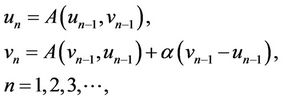 (3)
(3)
or
 (4)
(4)
where  thus
thus , and there exists a natural numbers m, if
, and there exists a natural numbers m, if , we have error estimates for iterative sequences (3) or (4):
, we have error estimates for iterative sequences (3) or (4):
 . (5)
. (5)
Proof. By the character of mixed monotone of A, then (1) and (C1), (C2) [in (1), (C2) where ] hold. In the following, we will prove (C3).
] hold. In the following, we will prove (C3).
Consider iterative sequence (3), since
 so we get
so we get

by the mathematical induction, we easily prove

hence

It is clear

For any ,
,  , since
, since
 thus there exists a natural numbers m, if
thus there exists a natural numbers m, if , such that
, such that

Moreover,

consequently, 
 ,
, .
.
Similarly, we can prove (4).
Theorem 2.2. Let  be L-ordering symmetric contraction operator, if there exists a
be L-ordering symmetric contraction operator, if there exists a  such that
such that
 then the following statements holds:
then the following statements holds:
(C4) Operator equation

has an unique of solution , and for its any coupled solution
, and for its any coupled solution , such that
, such that ;
;
(C5) For any , we make up symmetric iterative sequence
, we make up symmetric iterative sequence
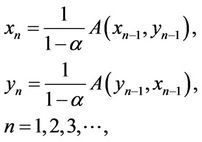 (6)
(6)
 (7)
(7)
then

and that for any  and
and , there exists a natural numbers m, if
, there exists a natural numbers m, if , then we have error estimates for iterative sequences (6) and (7) respectively:
, then we have error estimates for iterative sequences (6) and (7) respectively:
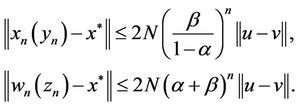 (8)
(8)
Proof. Set

or
 we can prove this theorem imitate proof of Theorem 2.1, over.
we can prove this theorem imitate proof of Theorem 2.1, over.
Similarly, we can prove following theorems.
Theorem 2.3. Let  be L-ordering symmetric contraction operator, if there exists a
be L-ordering symmetric contraction operator, if there exists a  such that
such that
 then the following statements holds:
then the following statements holds:
(C6) Equation

has an unique solution , and for any coupled solution
, and for any coupled solution  such that
such that ;
;
(C7) For any , we make up symmetric iterative sequence
, we make up symmetric iterative sequence
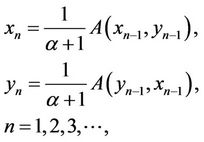 (9)
(9)
then that , moreover,
, moreover,  , there exist natural number m, if
, there exist natural number m, if , then we have error estimates for iterative sequence (9):
, then we have error estimates for iterative sequence (9):
 ;
;
(C8) For any 
 ,
,  , we make up symmetry iterative sequence
, we make up symmetry iterative sequence

Then
 and there exists a natural numbers m, if
and there exists a natural numbers m, if , we have error estimates for iterative sequence (8).
, we have error estimates for iterative sequence (8).
Remark 2. When , Corollary 2 in [4] is a special case of this paper Theorem 2.1 - 2.3.
, Corollary 2 in [4] is a special case of this paper Theorem 2.1 - 2.3.
Remark 3. The contraction constant of operator in [5] is expand into the contraction operator of this paper.
Remark 4. Operator A of this paper does not need character of mixed monotone as operator in [6].
3. Application
We consider that two point boundary value problems for two degree super linear ordinary differential equations
 (10)
(10)
Let  be Green function with boundary value problem (7), that is
be Green function with boundary value problem (7), that is

then that the solution with boundary value problem (7) and solution for nonlinear integral equation with type of Hammerstein
 (11)
(11)
is equivalent, where
 .
.
Theorem 3.1. Let  are nonnegative continuous function in
are nonnegative continuous function in
 .
.
If , then boundary value problem (7) have an unique solution
, then boundary value problem (7) have an unique solution  such that
such that
 ;
;
Moreover, for any initial function  such that
such that
 we make up iterative sequence
we make up iterative sequence
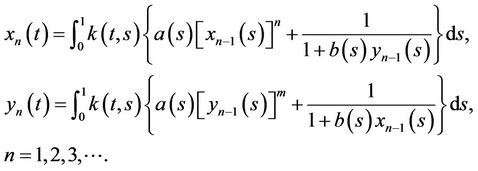
Then ,
,  uniform convergence to
uniform convergence to  on
on , and we have error estimates
, and we have error estimates

Proof. Let
 ,
,
 denote norm of E, then that E has become Banach space, P is normal cone of E and its normal constant N = 1. It is obvious that integral Equation (8) is transformed to operator equation
denote norm of E, then that E has become Banach space, P is normal cone of E and its normal constant N = 1. It is obvious that integral Equation (8) is transformed to operator equation , where
, where

Set
 then
then  denote ordering interval of E,
denote ordering interval of E,  is mixed monotone operator ,and
is mixed monotone operator ,and
 .
.
Set
 then
then  is bounded linear operator, its spectral radius
is bounded linear operator, its spectral radius  and for any
and for any ,
,  such that
such that  that is, A is L-ordering symmetric contraction operator, by Theorem 2.1 (where
that is, A is L-ordering symmetric contraction operator, by Theorem 2.1 (where ), then Theorem 3.1 has be proved.
), then Theorem 3.1 has be proved.
4. Acknowledgements
Supported by the Natural Science Foundation of Henan under Grant 122300410425; the NSF of Henan Education Bureau (2000110019); Supported by the NSF of Shangqiu (200211125).
REFERENCES
- D.-J. Guo and V. Lakshmikantham, “Coupled Fixed Points of Nonlinear Operators with Applications,” Nonlinear Analysis, Vol. 11, No. 5, 1987, pp. 623-632. doi:10.1016/0362-546X(87)90077-0
- Y. Sun, “A Fixed Point Theorem for Mixed Monotone Operators with Applications,” Journal of Mathematical Analysis and Applications, Vol. 21, No. 6, 1991, pp. 240-252.
- Q.-Z. Zhang, “Contraction Mapping Principle of Mixed Monotone Mapping and Applications,” Henan Science, Vol. 18, No. 2, 2000, pp. 121-125.
- J.-X. Sun and L.-H. Liu, “Iterative Solutions for Nonlinear Operator Equation with Applications,” Acta Mathematica Scientia, Vol. 13, No. 3, 1993, pp. 141-145.
- Q.-Z. Zhang, “Iterative Solutions of Ordering Symmetric Contraction Operator with Applications,” Journal of Engineering Mathematics, Vol. 17, No. 2, 2000, pp. 131- 134.
- X.-L. Yan, “The Fixed Point Theorems for Mixed Monotone Operator with Application,” Mathematical Application, Vol. 4, No. 4, 1991, pp. 107-114.

